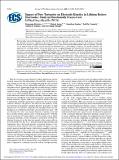Impact of Pore Tortuosity on Electrode Kinetics in Lithium Battery Electrodes: Study in Directionally Freeze-Cast LiNi 0.8 Co 0.15 Al 0.05 O 2 (NCA)
Author(s)
Delattre, Benjamin; Amin, Ruhul; Sander, Jonathan; De Coninck, Joël; Tomsia, Antoni P.; Chiang, Yet-Ming; ... Show more Show less
DownloadPublished version (1.261Mb)
Terms of use
Metadata
Show full item recordAbstract
The prevailing electrode fabrication method for lithium-ion battery electrodes includes calendering at high pressures to densify the electrode and promote adhesion to the metal current collector. However, this process increases the tortuosity of the pore network in the primary transport direction and imposes severe tradeoffs between electrode thickness and rate capability. With the aim of understanding the impact of pore tortuosity on electrode kinetics, and enabling cell designs with thicker electrodes and improved cost and energy density, we use here freeze-casting, a shaping technique able to produce low-tortuosity structures using ice crystals as a pore-forming agent, to fabricate LiNi0.8Co0.15Al0.05O2 (NCA) cathodes with controlled, aligned porosity. Electrode tortuosity is characterized using two complementary methods, X-ray tomography combined with thermal diffusion simulations, and electrochemical transport measurements. The results allow comparison across a wide range of microstructures, and highlight the large impact of a relatively small numerical change in tortuosity on electrode kinetics. Under galvanostatic discharge, optimized microstructures show a three- to fourfold increase in area-specific capacity compared to typical Li-ion composite electrodes. Hybrid pulse power characterization (HPPC) demonstrates improved power capability, while dynamic stress tests (DST) shows that an area-specific area capacity corresponding to 91% of the NCA galvanostatic C/10 capacity could be reached.
Date issued
2018-02Department
Massachusetts Institute of Technology. Department of Materials Science and EngineeringJournal
Journal of The Electrochemical Society
Publisher
The Electrochemical Society
Citation
Delattre, Benjamin et al. "Impact of Pore Tortuosity on Electrode Kinetics in Lithium Battery Electrodes: Study in Directionally Freeze-Cast LiNi 0.8 Co 0.15 Al 0.05 O 2 (NCA)." Journal of The Electrochemical Society 165, 2 (February 2018): A388-A395. ©2018 The Author(s)
Version: Final published version
ISSN
0013-4651
1945-7111